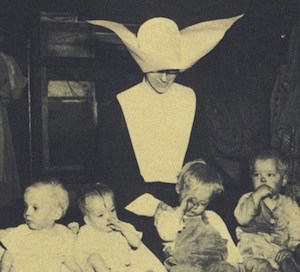The announcement in September that the Daughters of Charity will leave Austin by 2014, after 113 years in this community, came as a shock to those of us who chose to ignore reality and pretend they would be here forever. But that’s not how it works.

Sister Philomena Feltz, seen here on a home visit circa 1957, fed the hungry in Austin for 60 years.
When Saints Vincent de Paul and Louise de Marillac founded the Daughters of Charity in 1633 in France, the mission was for the Sisters to go out into the real world to meet real needs (rather than be cloistered). And when they accomplish their mission, they move on to others in need.
Ordained religious women arrived in what’s now the United States in 1727. From that first mission in New Orleans, they have cut a remarkably adventurous and entrepreneurial path, serving as de facto social service agencies for America’s great waves of immigrants and the poor. These deeply spiritual and intellectual pioneering women built and ran schools, hospitals, orphanages and more. Sisters professionalized teaching, nursing and social service in this country.
From the early 1800s through the late 1960s, American women were systematically excluded from leadership roles, couldn’t even vote until 1920. If you were a Catholic woman, you had far more opportunity for education and meaningful work within church structures. The number of women to take vows of poverty, chastity and obedience peaked at more than 181,000 in 1966, when the women’s movement and the Second Vatican Council opened the church to lay leadership. Today, there are around 51,000 women religious. With an average age in the mid-70s, they are all but extinct in hospitals.
“After much discernment and prayer, the Province of St. Louise decided to withdraw Sisters from nine U.S. Catholic dioceses and one archdiocese,” said Belinda Davis, a national spokeswoman for the Daughters. “Seven of these districts include Ascension Health facilities where the Daughters have judged the laity is prepared to ensure the continuation of the mission. This is especially true at Seton where the Daughters themselves have prepared the succeeding laity for many years in the Vincentian spirit.”
When the Daughters came to our town to open a hospital in 1900, it was an outback wilderness area on the shores of the Colorado River with a population of about 22,000. With tremendous community support, but not much else, in 1902 the Daughters opened the Seton Infirmary and the Seton School of Nursing. During the grand opening celebration, the hospital’s first patient was carried up the front steps of the hospital — prophetically, a charity patient. The hospital was staffed by the Sisters and student nurses. The old red-brick infirmary at Rio Grande and W. 26th streets has evolved into Central Texas’ largest health care system with a stable economic base. Their will be done.
For generations, the Sisters quietly ministered to the sick and dying, often with nothing more to offer than their presence. They cared for patients during the smallpox, Spanish flu, typhus and polio epidemics. They trained nurses for World War II.
Austin was hard-hit by the Depression, and Sr. Philomena was ever-present to feed the hungry, meeting the long bread lines that formed every day outside the infirmary. Former administrator Sr. Mary Rose McPhee, born in 1918 and now close to the end of her journey, worked with Dr. Jacob Kay and community support to bring neonatology to Central Texas, the setting where I had the privilege to work for 32 years.
Since arriving, the Daughters have been preparing the laity to continue the mission after they’re gone, for example, growing their own nurses at the Seton nursing school — and pushing for a school to educate doctors. Their mission is what attracted and keeps us in Seton’s 12,600-strong workforce.
With more than a century of enculturation, their spirit remains hard-wired into the work that we do every day and the planning for the medical school. Although they will no longer live in Austin, Daughters will remain active in Seton governance.
The Sisters are called to move on to serve where there is greater need, and we must let them go. Will the lay leadership succeed in continuing the mission? The Sisters are fully confident that they are. And that’s good enough for me.

 Austin, Texas
Austin, Texas